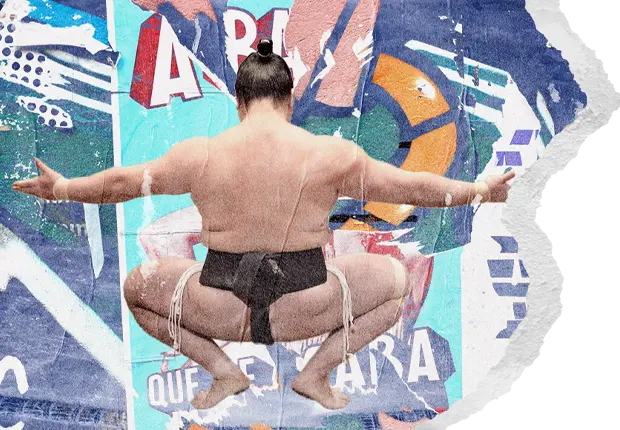Sumo: A Sport Against Time
In 2018, mayor Ryozo Tatami collapsed mid-speech in a dohyo, a sumo ring. Two women rushed atop the clay mound to administer first aid. Naturally, the referee ordered them away: a professional dohyo is a sacred male space, denied to women since the Shinto ritual known as sumo began over 1,000 years ago.
The video-recorded incident became an international scandal. The head of the Japan Sumo Association denounced the referee’s response as “inappropriate in a life-threatening situation.” Journalists pilloried Japan’s national sport for sexism. “Of course it is important to protect tradition, but the way it excludes women perhaps is out of step with the times,” said a Japanese newscaster.
This was not sumo’s first sexist incident. In 1990, the Chief Cabinet Secretary requested the honour of presenting the Prime Minister’s cup to a sumo grand champion, and was denied. So too was the governor of Osaka in 2000.
A dohyo is not the godless turf of other sports. It is built from scratch with traditional tools for each sumo tournament and consecrated by prehistoric ritual. Offerings of food and alcohol, buried in the clay, invite the presence of Shinto gods – at times drawing even the Emperor, direct descendant of the sun goddess Amaterasu. The yokozuna, the highest ranked wrestler, enters the dohyo flanked by attendants, one bearing a sword, and performs a cleansing Shinto ceremony on each day of a tournament. His corded, 35-pound shimenawa belt denotes a god within. A female presence would be contrived and sully the sacred space with a menstrual cycle. For the same reason, women were banned from climbing Mount Fuji up until a cultural revolution at the end of the 19th century. Today, they remain banned from Mount Omine and Okinoshima island.
The taboo goes against tolerance, money, and science: core tenets of the modern age. Why does it still exist? The Japanese simply answer, “tradition.”
Sumo’s glacial modernization makes it a gem among desiccated sports, but also a target. Netflix recently released a show called Sanctuary, featuring a vulgar, upstart sumo wrestler and an equally obnoxious journalist. Together they challenge sumo’s stuffy traditions and reveal its corruption.
The Netflix agenda is plain from the first episode when a thuggish wrestler crudely chastises Asuka for entering his gym’s dohyo. “The whole world needs to know about sumo’s dark side,” Asuka later exclaims. Indeed, so seems to be Netflix’s goal. Fraternity, lineage, and respect for hierarchy are dismissed, mocked, and misrepresented. The show is not really about sumo, but rather aspects of Japanese culture that globalists hate.
Sumo cannot help being a lightning rod; it is too pure. Wrestlers must keep their hair in a traditional topknot and wear a kimono in public. They are forbidden to drive motorized vehicles. They fight wearing a 30-foot loincloth that wraps around their waist and ties into a knot on the back. Cellphones and girlfriends are banned for wrestlers outside the top two divisions, and all except the elite live in a communal training facility. Violent hazing is the norm while boorish behaviour earns swift reprisal.
These arcane rules produce a culture of valour, perseverance, dignity, and martial spirit. These qualities compelled President Donald Trump to award a trophy of his creation – the United States President’s Cup – to a sumo grand champion. Trump said he hoped the cup would be awarded for “many hundreds of years.”
Imagine a millennium-old order of European knights that holds duelling tournaments throughout the year. There is no off-season and they wear the garb of Georgian England. Any European man can join, so long as he devotes his life to the order, upholds chivalric virtue, and lives in shared training quarters. That is what Japan has in sumo, yet Japanese youth are lately enamoured of Western sports. Playground dohyos have been replaced with baseball diamonds. Professional recruitment is at a fifty-year low. Journalists write that sumo will adapt or die, perhaps instinctively aware that sumo, like every other institution, has devolved over centuries.
Once upon a time, the Emperor settled sumo disputes. Referees, a form of Shinto priest, were later introduced and sorted into ranks. The most senior wore daggers that they used to cut open their stomachs in the case of an overturned decision. Referees still wear these daggers, yet they do not fall on them. Perhaps the daggers will be removed altogether, to make sumo tournaments safer. And why not allow women on the dohyo? The number of female fans has risen drastically in the last decade. Besides, Shinto is a sexist religion that should be put to bed. The kimono dress code is already laxly enforced. It’s time for sumo to grow up and move on…
Such talking points ring from the mouthpieces of the Cathedral. Thankfully, Japan continues to stymie them. Tradition runs deep, chasing money is publicly shamed, and ninety percent of Japanese practice Shinto rituals. They would not necessarily consider themselves Shintoists or followers of the Shinto religion – they are just Japanese. That is the fabric into which sumo is woven.
Between the bi-monthly grand tournaments, sumo wrestlers perform ritual bouts at Shinto shrines and ceremonial roles at festivals. The best, perhaps, is the 400-year-old Nakizumo festival, where sumo wrestlers carry babies onto the dohyo and see which one cries loudest. A cynic would say these public acts are nothing more than promotion for a sports show, but they are as inextricable as sumo’s head-first charge.
Sumo has survived worse than low viewership. In 1854, Commodore Perry forced an end to Japan’s 250-year policy of isolation. Foreign trade, freedom of religion, and democracy followed. The Tokugawa shogunate that ruled Japan for over 200 years collapsed within a decade. Sumo became passé, symbolic of a primitive past. Politicians pushed to have it cancelled. Funding evaporated. At its darkest hour the Emperor sponsored a series of tournaments, using sumo to preserve the nation’s sense of self in a time of crisis. From there, it rode a wave of Shinto nationalism that has lasted to this day. May it continue to be a beacon and the pride of Japan.
































